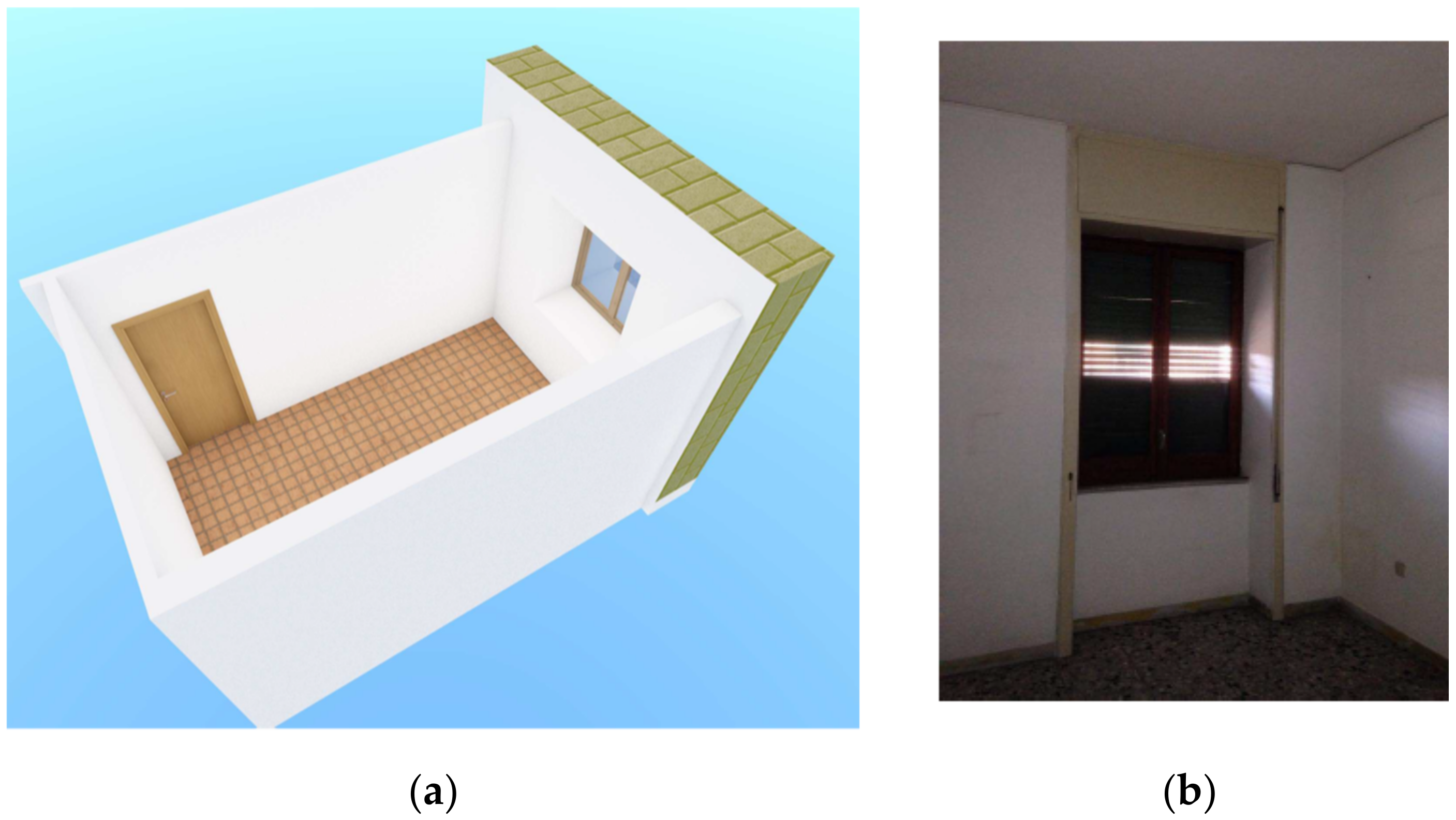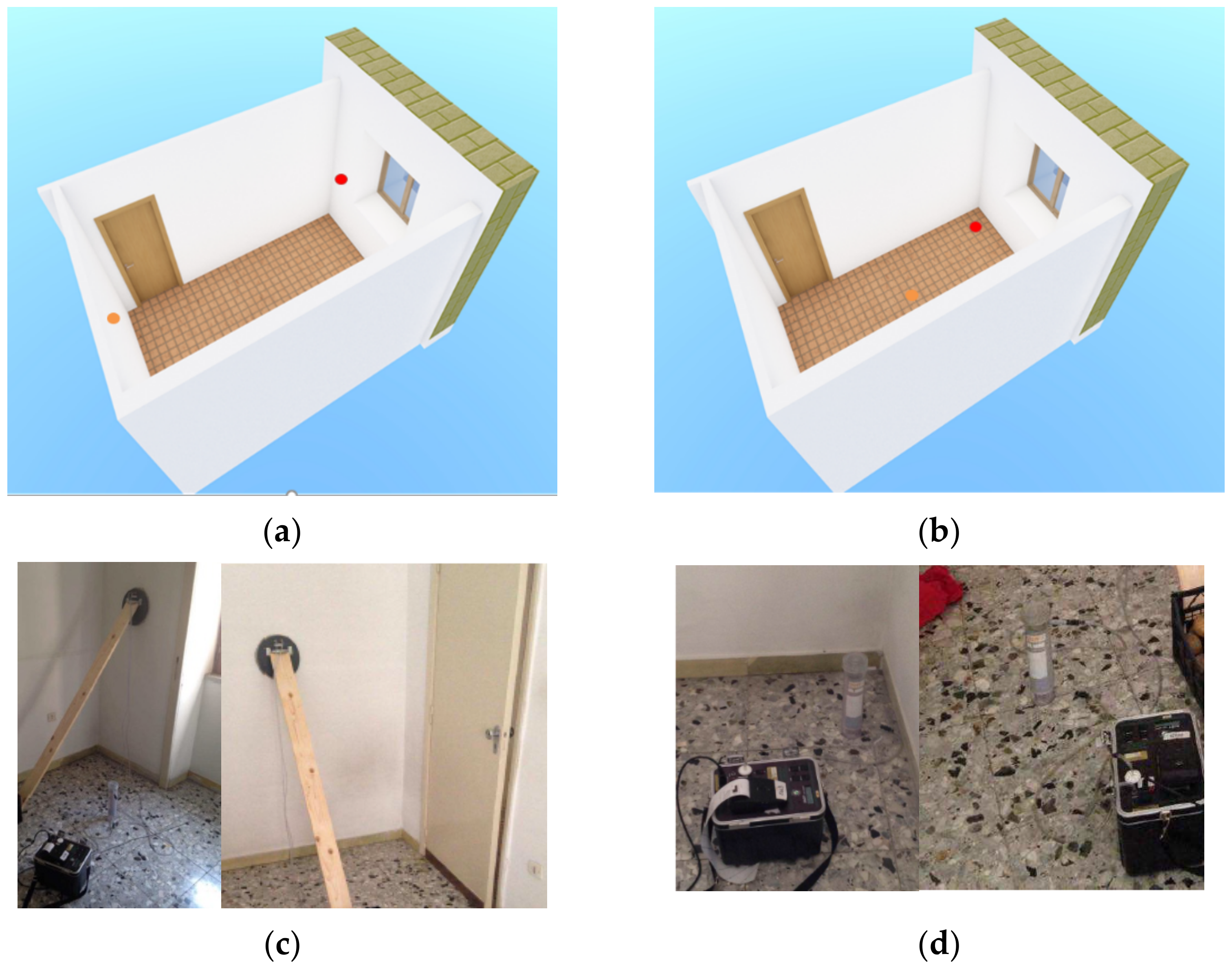Experimental Studies to Test a Predictive Indoor Radon Model
Abstract
:1. Introduction
2. Materials and Methods
2.1. Description of the Experimental Site
2.2. Description of Measurements
2.3. Description of the Model
3. Results and Discussion
4. Conclusions
Author Contributions
Funding
Institutional Review Board Statement
Informed Consent Statement
Conflicts of Interest
References
- World Health Organisation (WHO). WHO Handbook on Indoor Radon: A Public Health Perspective. 2019. Available online: https://apps.who.int/iris/handle/10665/44149 (accessed on 18 October 2021).
- Gruber, V.; Baumann, S.; Alber, O.; Laubbichler, C.; Bossew, P.; Petermann, E.; Ciotoli, G.; Pereira, A.; Domingos, F.; Tondeur, F.; et al. Comparison of radon mapping methods for the delineation of radon priority areas—An exercise. J. Eur. Radon Assoc. 2021, 2, 5755. [Google Scholar] [CrossRef]
- Elío, J.; Crowley, Q.; Scanlon, R.; Hodgson, J.; Long, S. Logistic regression model for detecting radon prone areas in Ireland. Sci. Total Environ. 2017, 599–600, 1317–1329. [Google Scholar] [CrossRef] [PubMed]
- Font, L.; Baixeras, C. The RAGENA dynamic model of radon generation, entry and accumulation indoors. Sci. Total Environ. 2003, 307, 55–69. [Google Scholar] [CrossRef]
- Cerqueiro-Pequeño, J.; Comesaña-Campos, A.; Casal-Guisande, M.; Bouza-Rodríguez, J.-B. Design and Development of a New Methodology Based on Expert Systems Applied to the Prevention of Indoor Radon Gas Exposition Risks. Int. J. Environ. Res. Public Health 2020, 18, 269. [Google Scholar] [CrossRef] [PubMed]
- Aközcan, S.; Külahcı, F.; Günay, O.; Özden, S. Radiological risk from activity concentrations of natural radionuclides: Cumulative Hazard Index. J. Radioanal. Nucl. Chem. 2021, 327, 105–122. [Google Scholar] [CrossRef]
- Bulko, M.; Holy, K.; Brandysova, A.; Mullerova, M.; Masarik, J. Study of the possibility of using radon potential maps for identifcation of areas with high indoor radon concentration. J. Radioanal. Nucl. Chem. 2021, 328, 651–657. [Google Scholar] [CrossRef]
- Mancini, S.; Vilnitis, M.; Guida, M. A Novel Strategy for the Assessment of Radon Risk Based on Indicators. Int. J. Environ. Res. Public Health 2021, 18, 8089. [Google Scholar] [CrossRef] [PubMed]
- Park, J.H.; Kang, D.R.; Kim, J. A review on mathematical models for estimating indoor radon concentrations. Ann. Occup. Environ. Med. 2016, 28, 7. [Google Scholar] [CrossRef] [PubMed] [Green Version]
- Mancini, S.; Guida, M.; Cuomo, A.; Guida, D. A geogenic approach for the Radon monitoring and the exposure assessment at a regional scale: The results of the Rad_Campania project. Adv. Geosci. 2020, 52, 87–96. [Google Scholar] [CrossRef]
- Mancini, S.; Guida, M.; Cuomo, A.; Guida, D.; Ismail, A.H. Modelling of indoor radon activity concentration dynamics and its validation through in-situ measurements on regional scale. AIP Conf. Proc. 2018, 1982, 020043. [Google Scholar] [CrossRef]
- DURRIDGE. RAD7 Electronic Radon Detector. User Manual; DURRIDGE Company Inc.: Billerica, MA, USA, 2020. [Google Scholar]
- Caridi, F.; D’Agostino, M.; Belvedere, A.; Marguccio, S.; Belmusto, G.; Gatto, M.F. Diagnostics techniques and dosimetric valuations for environmental radioactivity investigations. J. Instrum. 2016, 11, 102016. [Google Scholar] [CrossRef]
- Caridi, F.; D’Agostino, M.; Belvedere, A.; Marguccio, S.; Belmusto, G. Radon radioactivity in groundwater from the Calabria region, south of Italy. J. Instrum. 2016, 11, P05012. [Google Scholar] [CrossRef]
- Kitto, M.E.; Haines, D.E.; Diaz Arauzo, H. Emission of radon from decorative stone. In Proceedings of the American Association of Radon Scientists and Technologists 2008 International Symposium, Las Vegas, NV, USA, 14–17 September 2008. [Google Scholar]
- Fournier, F.; Groetz, J.E.; Jacob, F.; Crolet, J.M.; Lettner, H. Simulation of radon transport through Building materials: Influence of the water content on radon exhalation rate. Trans. Porous Med. 2005, 59, 197–214. [Google Scholar] [CrossRef]
- Rogers, V.C.; Nielson, K.K.; Holt, R.B. EPA Project Summary; EPA/600/SR-95/032 Air and Energy Engineering; EPA: Washington, DC, USA, 1995.
- Yarmoshenko, I.; Malinovsky, G.; Vasilyev, A.; Onishchenko, A. Model of radon entry and accumulation in multi-flat ener-gy-efficient buildings. J. Environ. Chem. Eng. 2021, 9, 105444. [Google Scholar] [CrossRef]
- Bochicchio, F.; Venuti, G.; Nuccetelli, C.; Risica, S.; Tancredi, F. Indoor measurements of 220Rn and 222Rn and their decay products in a Mediterranean climate area. Environ. Int. 1996, 22, 633–639. [Google Scholar] [CrossRef]
- Kuzmanovic, P.; Todorovic, N.; Petrovic, L.F.; Mrda, D.; Forkapic, S.; Nikolov, J.; Knezevic, J. Radioactivity of building materials in Serbia and assessment of radiological hazard of gamma radiation and radon exhalation. J. Radioanal. Nucl. Chem. 2020, 324, 1077–1087. [Google Scholar] [CrossRef]



| Protocol Name | Duration [hh:mm] | 222Rn Activity Concentration [kBq/m3] | Outdoor Weather Condition | |
|---|---|---|---|---|
| Temperature | Humidity | |||
| [°C] | [%] | |||
| GRAB | 00:30 | 15.20 ± 90 | 21 | 69 |
| GRAB | 00:30 | 9.22 ± 51 | 25 | 68 |
| Protocol Name | Duration [hh:mm] | 222Rn Activity Concentration [kBq/m3] | Description of the Wall |
|---|---|---|---|
| BM | 02:00 | 0.2 ± 0.06 | 50 cm yellow tuff covered by 2 cm of plaster |
| BM | 02:00 | 0.06 ± 0.03 | 10 cm clay brick covered by 1.5 cm of plaster |
| Protocol Name | Duration [hh:mm] | 222Rn Activity Concentration [kBq/m3] | 220Rn Activity Concentration [kBq/m3] | Outdoor Weather Condition | |
|---|---|---|---|---|---|
| Temperature | Humidity | ||||
| [°C] | [%] | ||||
| GRAB (thoron on) | 00:30 | 0.09 ± 0.04 1 | 0.08 | 4 | 31 |
| GRAB(thoron on) | 00:30 | 0.05 ± 0.02 2 | 0.05 | 32 | 55 |
| Protocol Name | Duration [hh:mm] | 222Rn Activity Concentration [kBq/m3] |
|---|---|---|
| GRAB | 00:30 | 0.30 ± 0.10 1 |
| GRAB | 00:30 | 0.18 ± 0.05 2 |
| Symbol | Description |
|---|---|
| Vi | Volume of the room |
| Sbm | BM surface area |
| Ci Ceq ED | indoor radon concentration equilibrium indoor radon concentration total rate of diffusion radon entry |
| Cbm | BM radon concentration |
| λrn | Radon decay constant |
| λ | ventilation rate factor |
| 222Rn Activity Concentration 1 [kBq/m3] | 222Rn Activity Concentration 2 [kBq/m3] | λ [h−1] |
|---|---|---|
| 0.31 ± 0.11 | 0.30 ± 0.09 | 0.23 |
| 0.18 ± 0.48 | 0.20 ± 0.05 | 0.39 |
| 0.09 ± 0.045 | 0.09 ± 0.03 | 0.74 |
| 0.05 ± 0.02 | 0.06 ± 0.02 | 1.20 |
Publisher’s Note: MDPI stays neutral with regard to jurisdictional claims in published maps and institutional affiliations. |
© 2022 by the authors. Licensee MDPI, Basel, Switzerland. This article is an open access article distributed under the terms and conditions of the Creative Commons Attribution (CC BY) license (https://creativecommons.org/licenses/by/4.0/).
Share and Cite
Mancini, S.; Vilnitis, M.; Todorović, N.; Nikolov, J.; Guida, M. Experimental Studies to Test a Predictive Indoor Radon Model. Int. J. Environ. Res. Public Health 2022, 19, 6056. https://doi.org/10.3390/ijerph19106056
Mancini S, Vilnitis M, Todorović N, Nikolov J, Guida M. Experimental Studies to Test a Predictive Indoor Radon Model. International Journal of Environmental Research and Public Health. 2022; 19(10):6056. https://doi.org/10.3390/ijerph19106056
Chicago/Turabian StyleMancini, Simona, Martins Vilnitis, Nataša Todorović, Jovana Nikolov, and Michele Guida. 2022. "Experimental Studies to Test a Predictive Indoor Radon Model" International Journal of Environmental Research and Public Health 19, no. 10: 6056. https://doi.org/10.3390/ijerph19106056
APA StyleMancini, S., Vilnitis, M., Todorović, N., Nikolov, J., & Guida, M. (2022). Experimental Studies to Test a Predictive Indoor Radon Model. International Journal of Environmental Research and Public Health, 19(10), 6056. https://doi.org/10.3390/ijerph19106056








